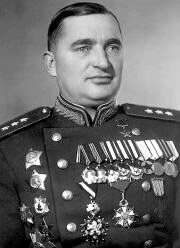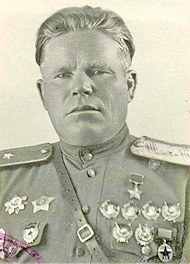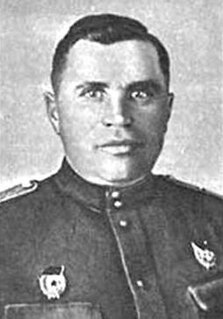Andrei Grigoryevich Kravchenko | |
|---|---|
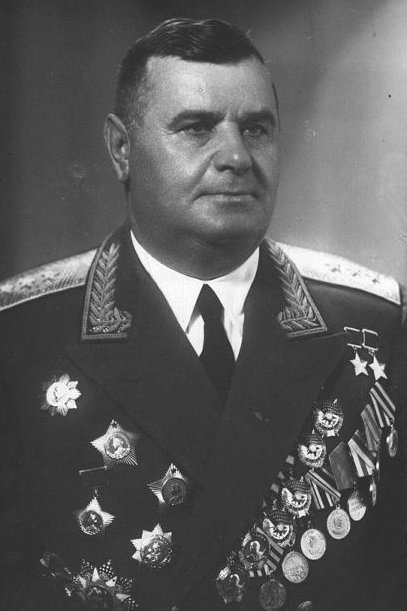 | |
| Native name | |
| Born | November 30, 1899 Sulimivtsy, Poltava Governorate, Russian Empire (now Ukraine) |
| Died | October 18, 1963 (aged 63) Moscow, Soviet Union |
| Allegiance | |
| Service/ | Red Army |
| Years of service | 1918–1955 |
| Rank | Colonel General |
| Battles/wars | Russian Civil War Soviet Finnish War Great Patriotic War |
| Awards | Hero of the Soviet Union (twice) Order of Lenin (5) Order of the Red Banner (4) Order of the October Revolution Order of Suvorov, 1st Class (3) Order of Kutuzov, Order of the British Empire |
Andrey Grigoryevich Kravchenko (Russian : Андре́й Григо́рьевич Кра́вченко; 30 November 1899 – 18 October 1963) was a tank army commander in the Soviet Army during the Great Patriotic War, twice Hero of the Soviet Union and recipient of several other awards.

Russian is an East Slavic language, which is official in the Russian Federation, Belarus, Kazakhstan and Kyrgyzstan, as well as being widely used throughout Eastern Europe, the Baltic states, the Caucasus and Central Asia. It was the de facto language of the Soviet Union until its dissolution on 25 December 1991. Although, nowadays, nearly three decades after the breakup of the Soviet Union, Russian is used in official capacity or in public life in all the post-Soviet nation-states, as well as in Israel and Mongolia, the rise of state-specific varieties of this language tends to be strongly denied in Russia, in line with the Russian World ideology.
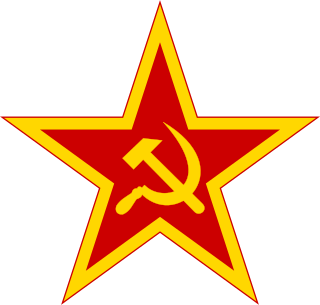
The Soviet Army is the name given to the main land-based branch of the Soviet Armed Forces between February 1946 and December 1991, when it was replaced with the Russian Ground Forces, although it was not fully abolished until 25 December 1993. Until 25 February 1946, it was known as the Red Army, established by decree on 15 (28) January 1918 "to protect the population, territorial integrity and civil liberties in the territory of the Soviet state." The Strategic Missile Troops, Air Defense Forces and Air Forces were part of the Soviet Army in addition to the Ground Forces.
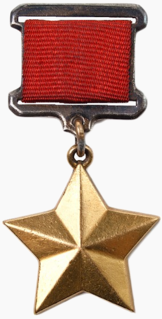
The title Hero of the Soviet Union was the highest distinction in the Soviet Union, awarded personally or collectively for heroic feats in service to the Soviet state and society.
Kravchenko was born in a farming family in the village of Sulimivtsy near Poltava, Ukraine. He was an ethnic Ukrainian. Kravchenko fought in the Russian Civil War. He was educated at the Poltava infantry Academy (1923) and the Frunze Military Academy. He subsequently served with the infantry and taught at the Saratov Tank Warfare school. From 1939 he was attached to the Volga Military District as chief of staff of the 61st Rifle Division. Kravchenko fought in the Soviet Finnish War as chief of staff of the 173rd Motorized Division. In 1940 Kravchenko was appointed chief of staff of the 16th Tank Division and later the 18th Mechanised Corps.

Poltava is a city located on the Vorskla River in central Ukraine. It is the capital city of the Poltava Oblast (province) and of the surrounding Poltava Raion (district) of the oblast. Poltava is administratively incorporated as a city of oblast significance and does not belong to the raion.

The Russian Civil War was a multi-party war in the former Russian Empire immediately after the two Russian Revolutions of 1917, as many factions vied to determine Russia's political future. The two largest combatant groups were the Red Army, fighting for the Bolshevik form of socialism led by Vladimir Lenin, and the loosely allied forces known as the White Army, which included diverse interests favoring political monarchism, economic capitalism and alternative forms of socialism, each with democratic and antidemocratic variants. In addition, rival militant socialists and nonideological Green armies fought against both the Bolsheviks and the Whites. Eight foreign nations intervened against the Red Army, notably the former Allied military forces from the World War and the pro-German armies. The Red Army eventually defeated the White Armed Forces of South Russia in Ukraine and the army led by Admiral Aleksandr Kolchak to the east in Siberia in 1919. The remains of the White forces commanded by Pyotr Nikolayevich Wrangel were beaten in Crimea and evacuated in late 1920. Lesser battles of the war continued on the periphery for two more years, and minor skirmishes with the remnants of the White forces in the Far East continued well into 1923. The war ended in 1923 in the sense that Bolshevik communist control of the newly formed Soviet Union was now assured, although armed national resistance in Central Asia was not completely crushed until 1934. There were an estimated 7,000,000–12,000,000 casualties during the war, mostly civilians. The Russian Civil War has been described by some as the greatest national catastrophe that Europe had yet seen.
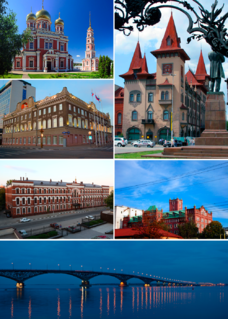
Saratov is a city and the administrative center of Saratov Oblast, Russia, and a major port on the Volga River located upstream (north) of Volgograd. Population: 837,900 (2010 Census); 873,055 (2002 Census); 904,643 (1989 Census).
Kravchenko commanded the 2nd Tank Corps, 4th Tank Corps, 5th Guards Tank Corps and 6th Guards Tank Army during World War II. He fought in the Battle of Moscow, the Battle of Stalingrad, [1] the Battle of Kursk at the Battle of Prokhorovka, the Battle of the Dnieper, the Korsun-Shevchenkovsky Offensive, [2] the Uman–Botoșani Offensive, the Jassy–Kishinev Offensive, the Vienna Offensive and the Bratislava–Brno Offensive. After the German surrender, Kravchenko's 6th Guards Tank Army was transferred to the Far East and fought in the Soviet invasion of Manchuria as part of the Transbaikal Front. [3] [4]

The 6th Guards Order of Red Banner Tank Army was a tank army of the Soviet Union's Red Army, first formed in January 1944 and disbanded in Ukraine in the 1990s after the dissolution of the Soviet Union. During its service in World War II, the army was commanded by Lieutenant General of Tank Troops Andrei Kravchenko.

World War II, also known as the Second World War, was a global war that lasted from 1939 to 1945. The vast majority of the world's countries—including all the great powers—eventually formed two opposing military alliances: the Allies and the Axis. A state of total war emerged, directly involving more than 100 million people from over 30 countries. The major participants threw their entire economic, industrial, and scientific capabilities behind the war effort, blurring the distinction between civilian and military resources. World War II was the deadliest conflict in human history, marked by 50 to 85 million fatalities, most of whom were civilians in the Soviet Union and China. It included massacres, the genocide of the Holocaust, strategic bombing, premeditated death from starvation and disease, and the only use of nuclear weapons in war.

The Battle of Moscow was a military campaign that consisted of two periods of strategically significant fighting on a 600 km (370 mi) sector of the Eastern Front during World War II. It took place between October 1941 and January 1942. The Soviet defensive effort frustrated Hitler's attack on Moscow, the capital and largest city of the Soviet Union. Moscow was one of the primary military and political objectives for Axis forces in their invasion of the Soviet Union.
Kravchenko graduated from the higher academic courses at the Military Academy of the General Staff in 1949. He subsequently commanded tank forces and was commander of the Far Eastern Military District from 1954. Kravchenko retired from the army in 1955 and served as a deputy in the Supreme Soviet. He died on October 18, 1963. He was buried in Moscow at the Novodevichy cemetery. A bronze bust to Kravchenko was installed at his former home in Sumy.

The General staff college of the Russian Federation's armed forces, also General staff academy of the Russian Federation's Armed Forces was founded in 1918 in Moscow by Leonid Govorov. It was the senior Soviet and now Russian general staff college.
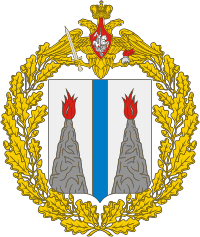
The Far Eastern Military District was a military district of the Armed Forces of the Russian Federation. In 2010 it was merged with the Pacific Fleet and part of the Siberian Military District to form the new Eastern Military District.

The Supreme Soviet of the Soviet Union was the most authoritative legislative body of the Union of Soviet Socialist Republics (USSR) beginning 1936, and the only one with the power to approve constitutional amendments. It elected the Presidium, served as the collective head of state of the USSR, and appointed the Council of Ministers, the Supreme Court, and the Procurator General of the USSR.




